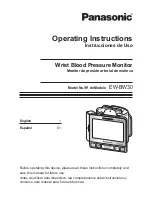
43
CHAPTER SIX
BOLT PREPARATION
The best balance between maximum frequency and noise suppression requires
selecting the best transducer for bolt measurement. The diameter of the transducer
(which is generally specified by the diameter of the actual piezoelectric crystal)
directly effects energy transmission: Larger diameter crystals have greater ability to
send and receive energy, and less of the energy tends to spread laterally. The
MAX
II
Bolt Tension Monitor strives to achieve this ideal balance: direct transmission of the
strongest possible pulse, with the least amount of noise and distortion, down and
back the center of the bolt to obtain the most accurate measurement.
6.1 Use of Ultrasonic Couplant
Sonic energy at the frequency range used by the
MAX II
travels well through solid
materials and most liquids. It does not travel well through air. This variable resistance
to the passage of sonic energy is called
sonic impedance
. It is the sudden change in
impedance which occurs when the sound pulse attempts to cross the metal / air
boundary at the end of the bolt, which causes most of the energy to be returned as
an echo. To make a familiar comparison: light crossing the transparent glass
boundary of a mirror and reflecting back an image from the nontransparent silvered
back is much like an echo.
Any air gap between the face of the transducer and the end of the bolt will prevent
the sonic energy from crossing. The gap must be filled with a suitable coupling fluid.
Normally, a liquid ultrasonic couplant is applied between the transducer and the bolt.
Since liquid has sonic impedance closer to the transducer and bolt material than air,
it forms a continuous path for the outgoing pulse and the returning echo.
Many liquids can serve as an adequate couplant, however liquids with lower sonic
attenuation will produce better results. Liquids containing glycerin offer such low
impedance, and couplant manufactured for ultrasonic testing, such as the one
shipped with the
MAX II
, produce the best results.
The single purpose of the couplant is to fill the air gap between the transducer and
the bolt end. This is accomplished more easily with a liquid that is viscous enough to
stay in place. Very viscous substances can create such a thick layer between the
transducer and bolt that measurement errors occur. Also, viscous substances can
trap air bubbles, which prevent adequate energy transmission. Again, the ultrasonic
couplant provided with the
MAX II
works best. Apply only the smallest quantity of
couplant required to fill the air gap, and carefully seat the transducer so that any
trapped air or excess couplant is squeezed out of the interface.
6.2 Transducer Contact Requirements
The goal is to transmit as much sonic energy as possible from the transducer into the
bolt, and to send that energy, to the greatest extent possible, down and back the
center of the bolt, as shown in Figure 1.
Summary of Contents for MAX II
Page 2: ......
Page 7: ......
Page 8: ......
Page 54: ...Dakota Ultrasonics 46 Figure 6 Reflection in a bending bolt ...
Page 215: ......
















































